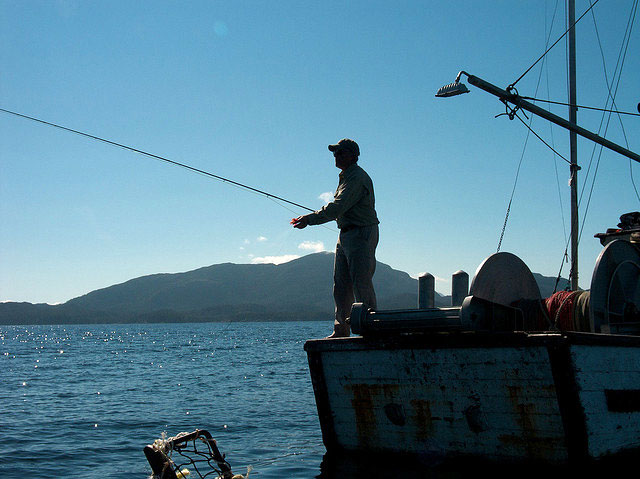How Low Can You Go? (Part II)

Sam Beebe photo
I fished northeast Florida over the holiday season and noticed a growing group of rebels that’s taking saltwater fly fishing and turning it on its head. They’re easily spotted, fishing right alongside spin casters and sporting chest or hip-packs, wading knee-level, and fishing light and sometimes ultra-light fly lines. Judging from the number of 5- and 6-weight rods around, this is clearly a new trend.
I ran into three small groups, one of which consisted of four Ohio natives, headed by Charlie, a “kind of former trout bum who still likes trout—but this has more oomph than trout fishing, if you know what I mean.”
No, Charlie, I don’t—please explain.
“One, the variety of fish you can hook is exponential compared with what you can expect back home [in freshwater] and pound-for-pound, these [saltwater] fish have far more torque than anything in freshwater.” After a bit more discussion, I realized that perception is indeed everything: even a one-and-a-half-pound jack or boxfish can be a prize on a 5- or 6-weight rig.
The rods generally range from 5- to 7-weight. I even spotted one person wielding a #4 fly rig that sported an Abel Creek fly reel (for those not familiar with the model, it’s a trout reel—and yes, it has a click drag). This person was targeting small jacks specifically. And what if you hook into a 10-pound snook? I asked. “We’re not here for large snook, or large anything. I fish the lightest saltwater leaders available, so anything over the 6- or 7-pound range will result in a break-off, which is fine. We’re conscientious, we’re careful, and take care not to exhaust fish.”
Charlie: “Naysayers always point out that fishing a #6 rig on a beach is nothing but a nuisance. Well, it’s certainly a bit more of a challenge, not relying on a 9-weight rod for wind-busting strength, but let’s be honest: if you’ve developed a solid cast, it can be done, and with relative ease. Cast low, cast tight [loops)] and directly into the wind and you’re good. Also, there are products out there that address some of these difficulties. What we look for are quick-loading lines with short, fat heads. Once again, we’re using ultra-light gear, but we aren’t chasing trout, so subtlety isn’t high on our list of requirements.
Also, we aren’t making 80-foot casts. Remember that the fish are generally right here at our feet. That said, we still have to turn over chunky flies—merkin crabs, medium-sized clousers, weighted shrimp—which is another reason short, slightly heavier heads are the order of the day.” (RIO’s new QuickShooter bonefish line is an excellent example. It has a short, easy-casting head that is designed to load rods at close range and is suited for anglers wading the flats or for novice saltwater anglers.)
There’s no shortage of techniques or leader formulas, either: “the general recipe is to give our leaders ‘the chop’—removing the last 18” to 24” right off the bat. We have to turn over some pretty large flies, relative to our gear, and most surf fish aren’t leader-shy, so the formula works out. I repeat: this isn’t trout fishing,or even bonefishing, for that matter.” Still, some of the hardcore members in the group are using full 9-footers that taper down to 8 and even 6 pounds. These are clearly the more proficient casters in the group.
Charlie: “There are definitely a few trade-offs. The fishing is unquestionably less focused since we’re after smaller saltwater fare, and, as with all types of fishing, we learn to expect the unexpected: my father-in-law landed a 26lb hammerhead using a 7-weight, and was able to accomplish this in ‘well under 10 minutes’—granted that it takes some fishing experience to accomplish that. The shark was released in very good condition.”
Barracuda in the 1- to 6-pound range populate nearly every stretch of water, so poppers are a pretty consistent treat. The system requires a super-short leader, normally trimmed down to 66” or 60” and finished off with 4” to 6” of bite guard. You’d be surprised at the distance a mid-sized popper can be cast using that leader formula.
Backing capacity seems like the only undetermined component so far. Some equip their mid-size reels with plenty, in the event of an unexpected bonefish or permit take. Many others use very little of it (as little as 80 yards in some cases). “Risky? Without question. Some days, break-offs can be the rule rather than the exception in this game.”
Rods themselves are a non-issue. They’re widely available and up to the task. St. Croix, Sage, Orvis and several other manufacturers make stiff, fast-action saltwater fly rods, the lightest of which are usually 6-weights.
On the growing numbers, “… a few short years ago, we consisted of a very select group of people. We’d get plenty of odd looks, and still do, but attitudes are definitely changing.”
A Bass Pro Shops salesperson supported this, telling me that sales of light saltwater fly rods and fly lines have shot through the roof in the last 12 to 18 months. He also offered that “many of these people are either totally new to salt water fly fishing, or just unable – or unwilling – to spend the dollars required to chase billfish, or other saltwater species of the more glorious variety”.











